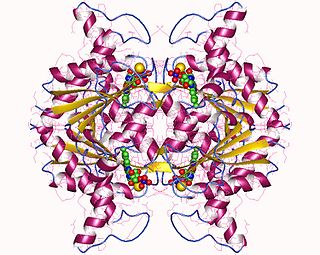
Glycolysis is the metabolic pathway that converts glucose into pyruvate and, in most organisms, occurs in the liquid part of cells. The free energy released in this process is used to form the high-energy molecules adenosine triphosphate (ATP) and reduced nicotinamide adenine dinucleotide (NADH). Glycolysis is a sequence of ten reactions catalyzed by enzymes.
Glyceraldehyde-3-phosphate dehydrogenase (NADP+) (GAPN) is an enzyme that irreversibly catalyzes the oxidation of glyceraldehyde-3-phosphate (GAP) to 3-phosphoglycerate using the reduction of NADP+ to NADPH. GAPN is used in a variant of glycolysis that conserves energy as NADPH rather than as ATP. The NADPH and 3-PG can then be used for synthesis. The most familiar variant of glycolysis uses glyceraldehyde-3-phosphate dehydrogenase (GAPDH) and phosphoglycerate kinase to produce ATP. GAPDH is phosphorylating. GAPN is non-phosphorylating.

Glycerol-3-phosphate dehydrogenase (GPDH) is an enzyme that catalyzes the reversible redox conversion of dihydroxyacetone phosphate to sn-glycerol 3-phosphate.
In enzymology, a sorbitol-6-phosphate dehydrogenase (EC 1.1.1.140) is an enzyme that catalyzes the chemical reaction
In enzymology, an erythrose-4-phosphate dehydrogenase (EC 1.2.1.72) is an enzyme that catalyzes the chemical reaction

In enzymology, a D-xylulose reductase (EC 1.1.1.9) is an enzyme that is classified as an Oxidoreductase (EC 1) specifically acting on the CH-OH group of donors (EC 1.1.1) that uses NAD+ or NADP+ as an acceptor (EC 1.1.1.9). This enzyme participates in pentose and glucuronate interconversions; a set of metabolic pathways that involve converting pentose sugars and glucuronate into other compounds.
In enzymology, a glycerol-3-phosphate 1-dehydrogenase (NADP+) (EC 1.1.1.177) is an enzyme that catalyzes the chemical reaction

In enzymology, a glycerol-3-phosphate dehydrogenase (NAD+) (EC 1.1.1.8) is an enzyme that catalyzes the chemical reaction
In enzymology, a glycerol dehydrogenase (NADP+) (EC 1.1.1.72) is an enzyme that catalyzes the chemical reaction
In enzymology, an inositol 2-dehydrogenase (EC 1.1.1.18) is an enzyme that catalyzes the chemical reaction
In enzymology, a 4-hydroxythreonine-4-phosphate dehydrogenase (EC 1.1.1.262) is an enzyme that catalyzes the chemical reaction
In enzymology, a 4-phosphoerythronate dehydogenase (EC 1.1.1.290) is an enzyme that catalyzes the chemical reaction
In enzymology, a L-glycol dehydrogenase (EC 1.1.1.185) is an enzyme that catalyzes the chemical reaction
In enzymology, a mannitol-1-phosphate 5-dehydrogenase (EC 1.1.1.17) is an enzyme that catalyzes the chemical reaction
In enzymology, a ribitol-5-phosphate 2-dehydrogenase (EC 1.1.1.137) is an enzyme that catalyzes the chemical reaction
In enzymology, a glyceraldehyde-3-phosphate dehydrogenase (ferredoxin) (EC 1.2.7.6) is an enzyme that catalyzes the chemical reaction
In enzymology, a glyceraldehyde-3-phosphate dehydrogenase (NAD(P)+) (EC 1.2.1.59) is an enzyme that catalyzes the chemical reaction
In enzymology, a glyceraldehyde-3-phosphate dehydrogenase (NADP+) (phosphorylating) (EC 1.2.1.13) is an enzyme that catalyzes the chemical reaction

In enzymology, a NAD(P)H dehydrogenase (quinone) (EC 1.6.5.2) is an enzyme that catalyzes the chemical reaction

1-Arseno-3-phosphoglycerate is a compound produced by the enzyme glyceraldehyde 3-phosphate dehydrogenase, present in high concentrations in many organisms, from glyceraldehyde 3-phosphate and arsenate in the glycolysis pathway. The compound is unstable and hydrolyzes spontaneously to 3-phosphoglycerate, bypassing the energy producing step of glycolysis.







